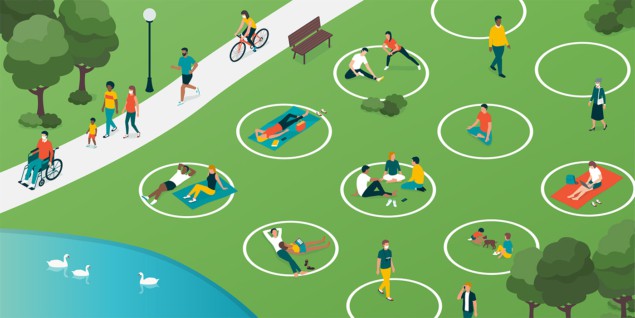In this article (originally published in Lateral Thoughts, Physics World’s regular column of humorous and offbeat essays, puzzles, crosswords, quizzes and comics, which appears on the back page of the print edition), Hamish Johnston wonders how best to pack people into a park, while respecting COVID-19 social-distancing regulations

In these tough times of the COVID-19 pandemic, one of the safest ways of mixing with friends is to meet up in a local park. But what 2D configuration, lattice or otherwise, offers the best way to maintain the appropriate social distance? Many years ago, I did a PhD on properties of 2D atomic lattices, so I thought I might have the answer to that question – how wrong I was. My rather unsatisfactory answer is, “it depends”.
One criterion you might consider when advising people where to sit is simplicity – after all, most folks are not familiar with crystallography and may not be able (or indeed willing) to create a 2D Bravais lattice in their local park. So, perhaps it is best to go with a familiar square lattice. But there are two problems here – one is that you only have four nearest neighbours to chat with, and if you extend your social circle out to next-nearest neighbours, there are just four of those as well. The second problem is that a square lattice does not make efficient use of our precious green space – it delivers a 78% efficiency when it comes to packing in personal bubbles of fixed diameter.
In contrast, a hexagonal lattice makes use of 91% of available space – which is why this is called a “close-packed” arrangement. The hexagonal lattice is also 50% more social than a square lattice, because everyone has six nearest neighbours. There’s also more room for the party to grow, because you also have six next-nearest neighbours. A possible downside of this structure is that it could be more difficult for people to arrange themselves in a hexagonal lattice – ensuring that your six nearest neighbours are all at 60˚ from each other seems trickier than arranging your four nearest neighbours at right angles. However, if everyone carried a metre-stick, then you could take advantage of the close-packed nature of the lattice by having people trace out a circle around them so that their circle touched on the circles of six other people.
Just as we have 2 m markers on the floor to tell us how to space ourselves in a 1D queue, humans probably need a bit of help to crystallize in 2D
Just as we have 2 m markers on the floor to tell us how to space ourselves in a 1D queue, humans probably need a bit of help to crystallize in 2D. I think social distancing in a park is best done as an epitaxial process, where someone from the parks department provides a suitable substrate by painting a lattice of close-packed circles on the grass before everyone arrives with their picnic baskets. But human epitaxy has its challenges because interactions between individuals could cause something akin to a surface reconstruction. This occurs when atoms deposited on a surface sit where they want, rather than adhering to the underlying lattice structure. This process is referred to as “relaxation”, which is exactly the sort of thing you would expect to occur on a sunny Saturday afternoon in the park after the consumption of many gins-in-a-tin.
So, if you want to socially distance in an efficient way with 12 friends, then a hexagonal lattice is the winner. But are there downsides to close packing? How would you, for example, join a group of friends in the middle of a busy park who have kindly left a space for you? If the park is not too full, you might be able to hop like a highly correlated electron from one empty lattice site to the next. I’m not sure if a partially full square or hexagonal lattice is the easiest to navigate in this way – I will leave that calculation to you – but one way of getting through a partially full park would be to rearrange people back and forth as you move through, much like those moving-tile puzzles of numbered squares that you find in Christmas crackers. I don’t know if such a solution can be computed, but working out the best route and rearrangement of people on a 2D lattice is probably best addressed by a quantum annealer.
On a warm sunny afternoon, however, hopping like an electron through a crowded park is impossible. The lattice is in the insulator state, and the only way to get to your friends is to defy the laws of physics, and social-distancing, and charge on through. This is where the square lattice could offer an advantage because the lower packing density means you could manage to stay further away from people than you could in a hexagonal lattice – but you would still break the 2 m rule.
Glass on the grass
So do any other 2D arrangements offer benefits? One problem with lattices is that people tend to line up along specific directions, which means that your near neighbours tend to block your line of sight to friends who are further away. This could be a moot point because shouting across 4 m or more is not particularly sociable. But if you wanted a direct line of sight to lots of faraway neighbours, the solution could be a glass-like structure in which people are scattered about the park, at a minimum 2 m distance between individuals. I suspect that this arrangement would naturally emerge in a park if people sat where they wished. And perhaps there would be some sort of phase transition to a hexagonal lattice at a critical density?
The finite nature of a park also comes to bear on social distancing. Lattices, after all, are infinite constructs and a close-packed arrangement is not always the most efficient way to pack spheres within a confined space. If a square garden only has room for 12 people, for example, a hexagonal arrangement works best – but a garden with room for 16 is best filled by a square lattice. And between these two, the most efficient configurations are jumbled and do not have a lattice structure.
Park boundaries are a problem because they break a lattice’s translational symmetry – so why not choose a quasicrystal arrangement that does not have translational symmetry? I’ll leave that thought for the reader to ponder after a few cold ones in the blazing sunshine.



